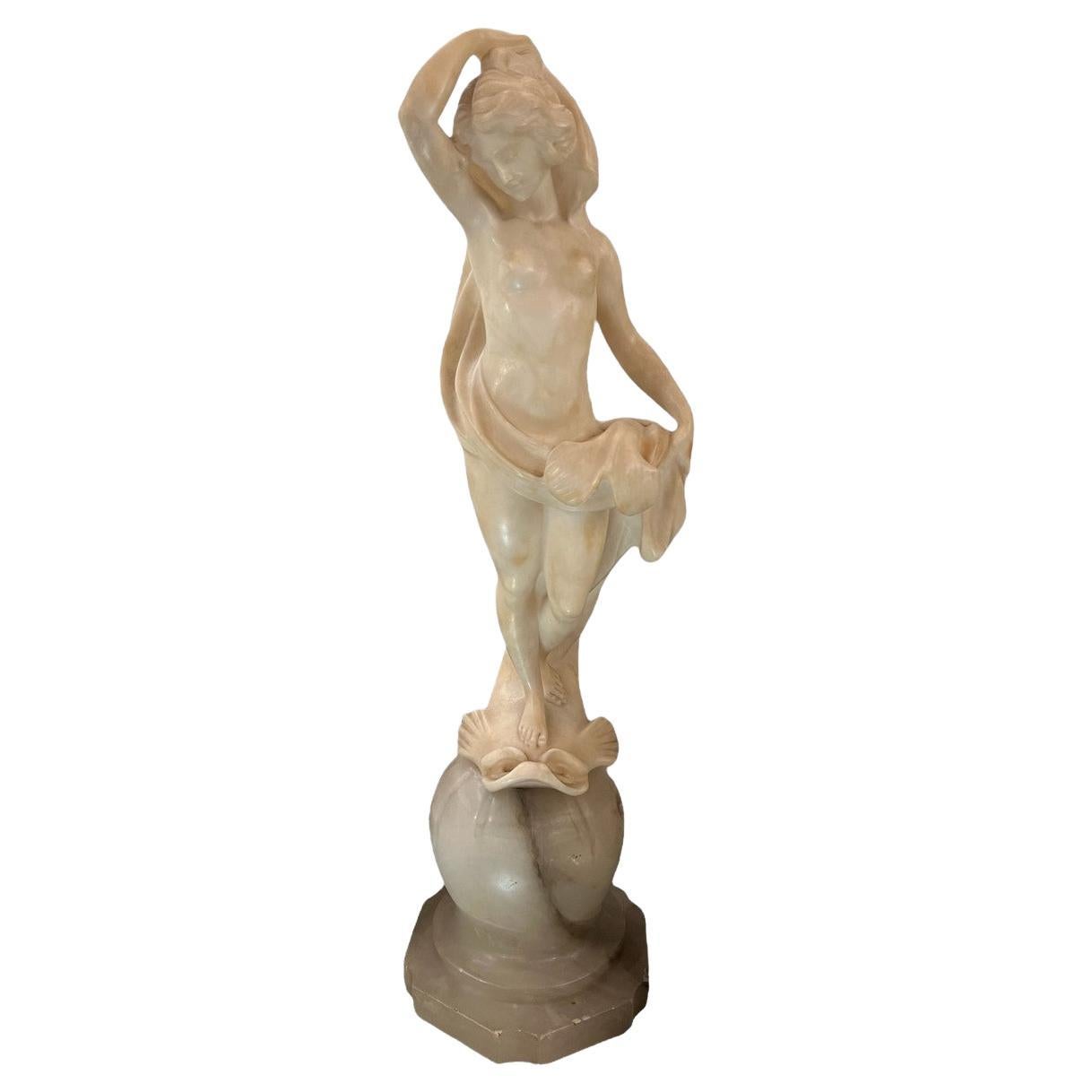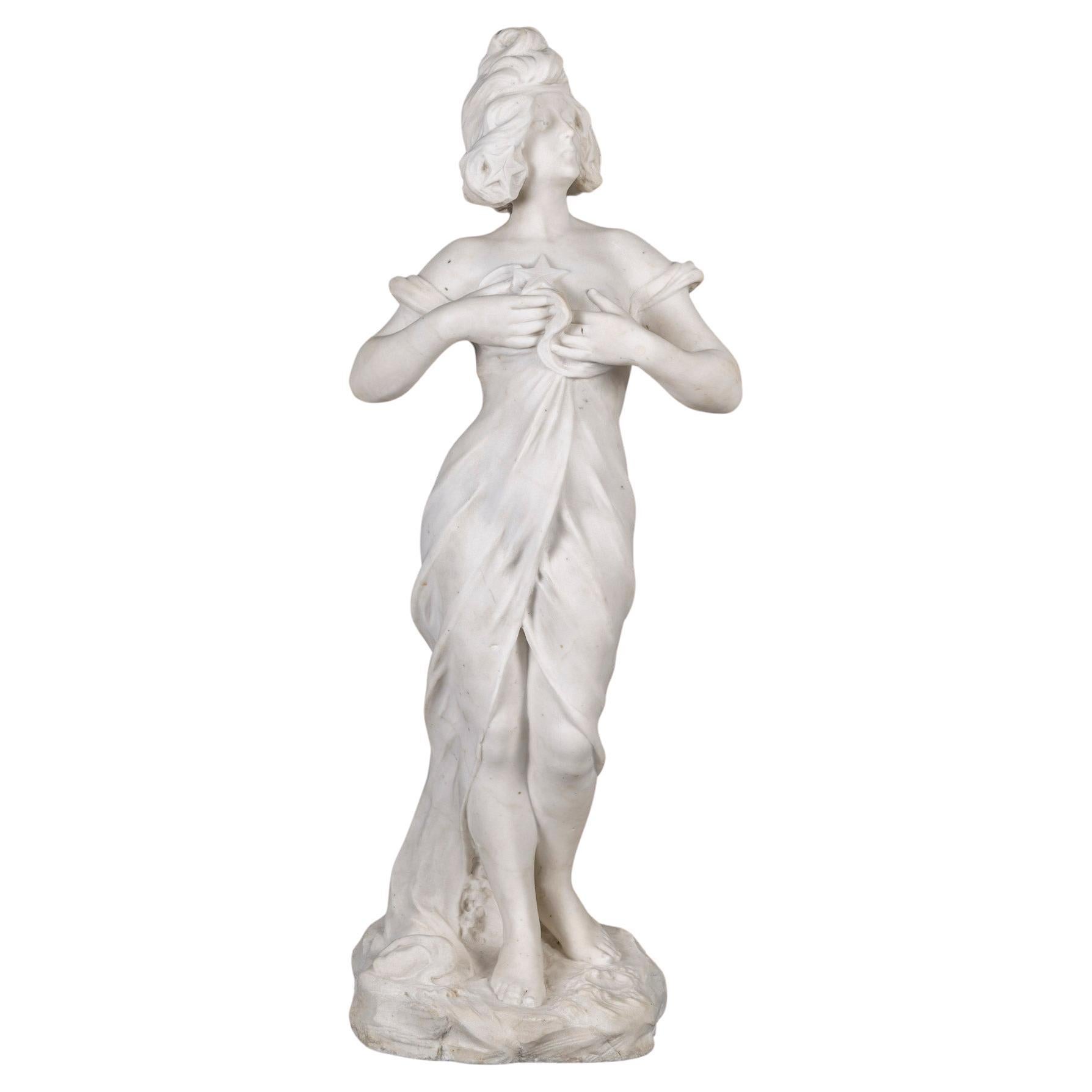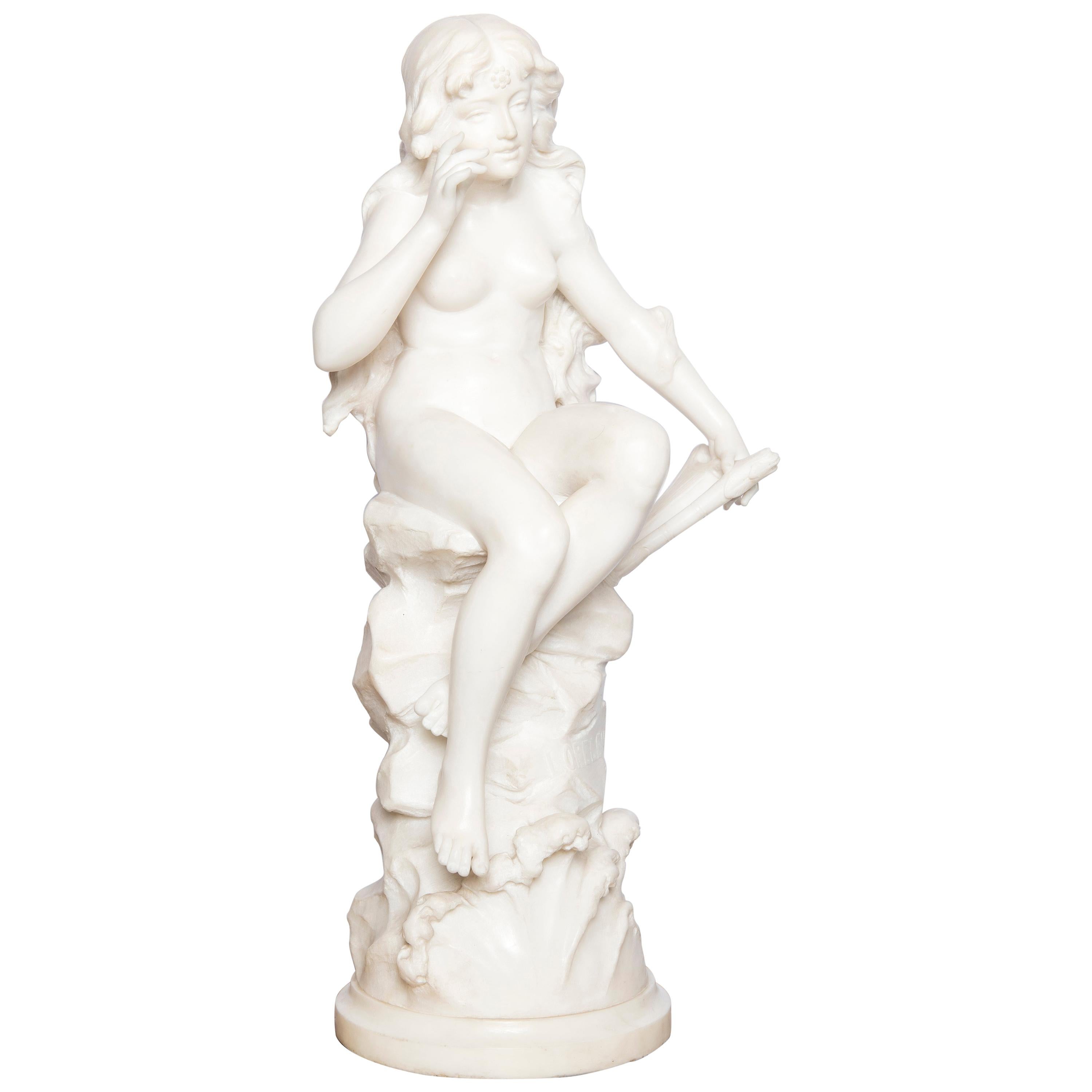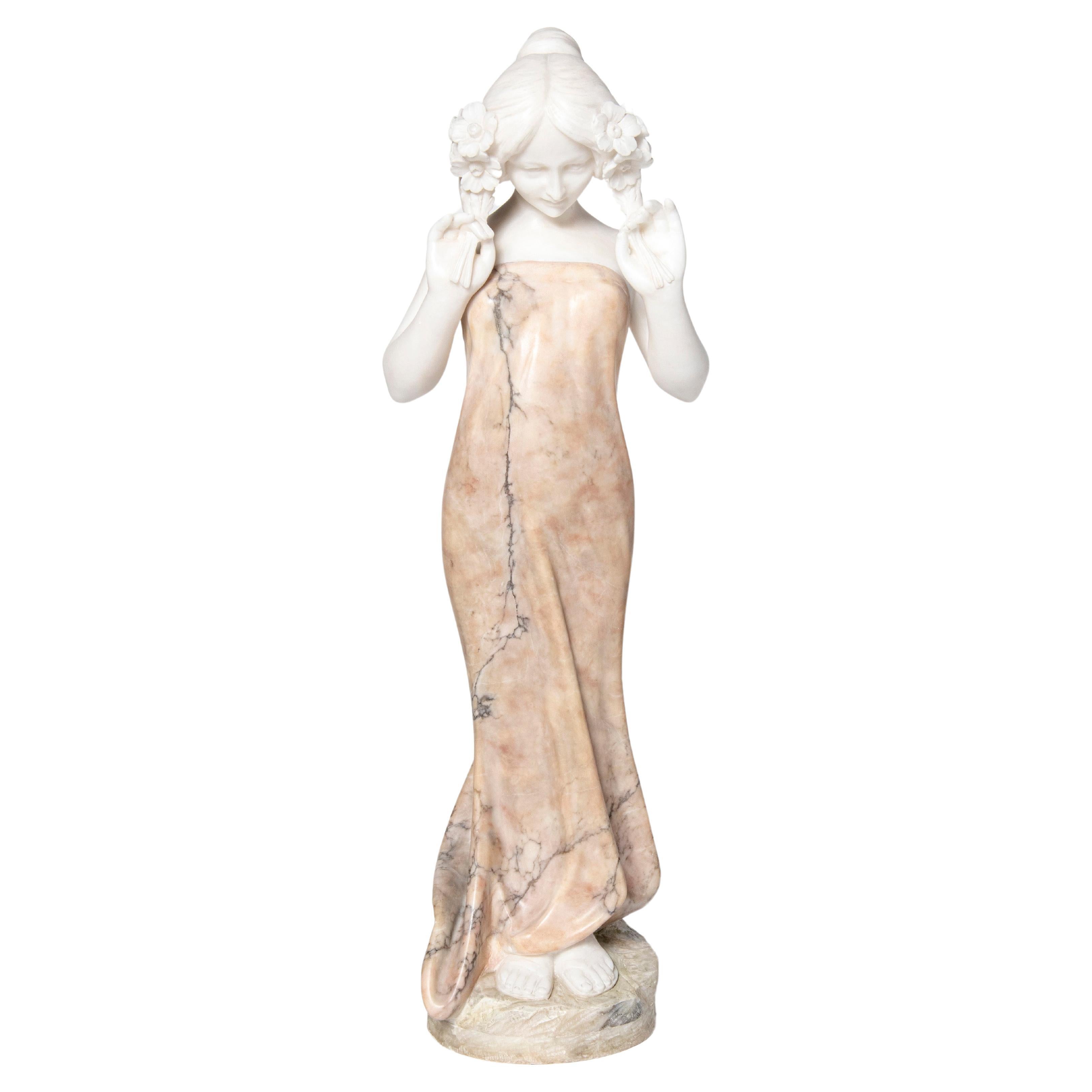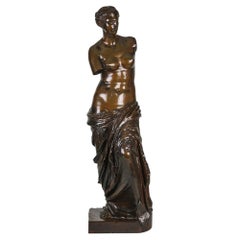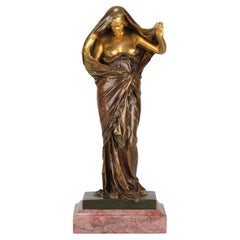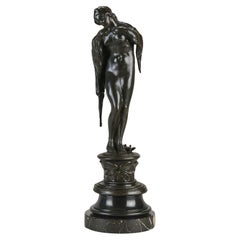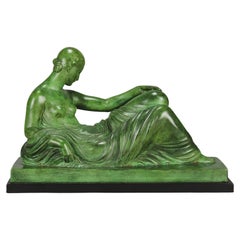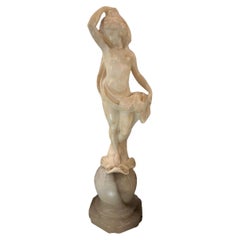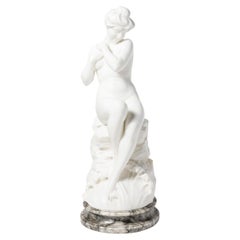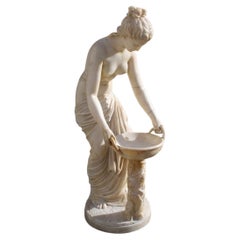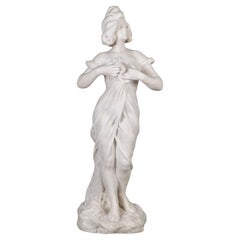Items Similar to Late 19th Century Art Nouveau Marble Sculpture "Femme Assis" by Carlo Pittaluga
Want more images or videos?
Request additional images or videos from the seller
1 of 12
Late 19th Century Art Nouveau Marble Sculpture "Femme Assis" by Carlo Pittaluga
$10,330.94
£7,500
€8,841.20
CA$14,206.59
A$15,801.38
CHF 8,270.10
MX$192,724.74
NOK 103,916.87
SEK 97,747.23
DKK 65,990.95
About the Item
A captivating late 19th Century Art Nouveau hand carved marble figure of a young beauty seated on a rock with a look of deep contemplation on her face with excellent surface detail, raised on a marble base and signed Pittaluga
ADDITIONAL INFORMATION
Height: 71 cm
Width: 22 cm
Depth: 22 cm
Condition: Excellent Original Condition
Circa: 1900
Materials: Marble
SKU: 9326
ABOUT
Carlo Pittaluga was an Italian sculptor active in the early 20th century. Renowned for his elegant female figures, his works embody the Art Nouveau style. Notably, his marble sculptures "Nymph of the Woods" and "Nymph of the Fields" (both 1915) are housed in the National Gallery of Art in Washington, D.C.
Despite his artistic achievements, detailed biographical information about Pittaluga remains scarce. His sculptures continue to be appreciated for their graceful forms and are featured in various art collections and galleries.
- Dimensions:Height: 27.96 in (71 cm)Width: 8.67 in (22 cm)Depth: 8.67 in (22 cm)
- Style:Art Nouveau (Of the Period)
- Materials and Techniques:
- Place of Origin:
- Period:
- Date of Manufacture:1900
- Condition:Wear consistent with age and use.
- Seller Location:London, GB
- Reference Number:Seller: 93261stDibs: LU3216344078662
About the Seller
5.0
Vetted Professional Seller
Every seller passes strict standards for authenticity and reliability
Established in 1936
1stDibs seller since 2017
84 sales on 1stDibs
Typical response time: <1 hour
- ShippingRetrieving quote...Shipping from: London, United Kingdom
- Return Policy
Authenticity Guarantee
In the unlikely event there’s an issue with an item’s authenticity, contact us within 1 year for a full refund. DetailsMoney-Back Guarantee
If your item is not as described, is damaged in transit, or does not arrive, contact us within 7 days for a full refund. Details24-Hour Cancellation
You have a 24-hour grace period in which to reconsider your purchase, with no questions asked.Vetted Professional Sellers
Our world-class sellers must adhere to strict standards for service and quality, maintaining the integrity of our listings.Price-Match Guarantee
If you find that a seller listed the same item for a lower price elsewhere, we’ll match it.Trusted Global Delivery
Our best-in-class carrier network provides specialized shipping options worldwide, including custom delivery.More From This Seller
View AllLate 19th Century Art Nouveau Sculpture "Venus de Milo" by F. Barbedienne
By F. Barbedienne Foundry
Located in London, GB
A large and impressive late 19th Century bronze study of the famous Venus de Milo sculpture of antiquity with excellent rich brown patina and good hand finished surface detail, inscribed F.Barbedienne foundry
ADDITIONAL INFORMATION
Height: 95 cm
Width: 28 cm
Depth: 28 cm
Condition: Excellent Original Condition
Circa: 1890
Materials: Bronze
Foundry: F.Barbedienne
SKU: 7741
ABOUT
The Barbedienne Foundry is a famous 19th century bronze foundry, whose statues and art objects became rapidly very renowned. This bronze studio co-worked with other trades, and put his name to a great variety of works, such as furnishing in particular. Attending every World's Fair of its time, the Barbedienne Foundry was regularly awarded, notably at the World's Fair of 1855 where it was awarded the Great Medal of Honor.
A Parisian bronze maker and caster, Ferdinand Barbedienne (1810-1892) creates a firm in 1839 in collaboration with Achille Collas, the inventor of the mechanical method to obtain copies of sculptures at a smaller scale. With this groundbreaking proceed, they facilitated an unprecedented production. Under the “Collas et Barbedienne” name, they specialized in Antiquity copies and perfected new chemical methods for the color and patina finish of their bronzes. As a true Romantic, Ferdinand Barbedienne is committed to democratization of arts, he thus realizes numerous Antiquity copies and stimulates his contemporaries’ works broadcasting. A great deal of famous sculptures are hence cast by the Barbedienne Foundry. All his life, Barbedienne co-worked with the greatest artists, sculptors or designers of his time, such as Edouard Lievre, Ferdinand Levillain, Attarge, Aizelin, Barye or Fremiet.
Statues aside, he products a great deal of decorative artifacts, such as clocks, vases, mirrors, etc. Since 1855, Ferdinand Barbedienne collaborates with the famous decoration designer Louis-Constant Sévin (1821-1888). Joining the firm as a sculptor-designer, he stays loyal to it his life long, always finding more new designs for daily objects, which hence become true art works. Sevin’s creations, specialized in the “Neo-Greek” style, were particularly appreciated for antiquity reference in decorative arts, just like the great mirror preserved by the Orsay Museum. He also teams up with enamelers including Alfred Serre, and develops a set of “cloisonnés” enamels that made the headlines at the World's Fair of 1862 in London, which was the very beginning of the art of enamel’s return. In collaboration with Serre, Barbedienne realized between 1878 and 1889 the Monumental Clock in Renaissance style, decorated with enamels, which is preserved in the Paris City Hall.
Venus de Milo
Facts about Venus de Milo sculpture.
For much of the world, the mystery of the Venus de Milo lies in her missing arms. But there’s much more to this iconic statue than a couple of absent appendages.
1. Venus de Milo‘s title is a bit misleading.
It’s popularly believed that this Grecian statue depicts the Greek Goddess of love and beauty, who was often rendered half-naked. However, the Greeks would have called this deity Aphrodite. Nonetheless, the Roman-inspired Venus de Milo caught on.
2. She’s named in part for where she was discovered.
On April 8, 1820, a farmer named Yorgos Kentrotas came across the statue in pieces within the ruins of an ancient city on the island of Milos (formerly known as Melos).
3. Alexandros of Antioch is credited with her creation.
A sculptor of the Hellenistic period, Alexandros is believed to have carved this masterpiece between 130 and 100 BCE. The inscription on the plinth—the slab on which the statue rested—that identified him as Venus de Milo‘s creator was lost nearly 200 years ago.
4. She might not be Venus.
Some have suggested the sculpture is not Aphrodite/Venus, but Amphitrite, the sea goddess who was particularly adored on Milos. Still others have proposed she’s Victory, or perhaps a prostitute. With her arms long missing, would-be context clues have been lost for centuries. A spear could have meant one thing, a spool of thread another. If she held an apple—as some reports claim—it could mean she was Aphrodite, holding the award given to her by Paris before the Trojan War began. To this day, it’s a matter of passionate debate.
5. She became a gift to the King of France.
When Kentrotas called upon a French naval officer to help him unearth the spectacular sculpture, he began a chain of events that would eventually lead to the Marquis de Rivière presenting Venus de Milo to Louis XVIII. In turn, the ruler gave the statue to the Louvre, where it is on display to this very day.
6. The loss of her limbs is the fault of the French.
Kentrotas did find fragments of an arm and a hand when he uncovered the statue in the ruins, but as Venus de Milo was being reassembled, those arms were discarded for having a “rougher” appearance. Modern art historians believe that the variation of finish does not mean those arms did not belong to Venus, but both the arms and the original plinth have been lost since the piece moved to Paris in 1820.
7. The original plinth was ditched on purpose.
Sight unseen, early 19th century art historians decided the newly discovered Venus must have been the work of Greek artist Praxiteles, and publicized the work as such. This attribution would have placed the piece in the Classical period (5th through 4th centuries BCE), which was more respected artistically than the Hellenistic period. To save face and better promote Venus de Milo—even at the cost of misinforming the public—the plinth was removed before it was presented to the King.
8. Venus de Milo was meant to make up for a national embarrassment.
During his conquests, Napoleon Bonaparte had plundered one of the finest examples of Greek sculpture, Venus de’ Medici, from Italy. In 1815, the French government returned that beloved sculpture, but in 1820, France embraced the chance to fill the hole its absence left in the French culture and national pride. As such, Venus de Milo was promoted as being even greater than Venus de’ Medici upon her Louvre debut. The ploy worked, and the piece was met with almost universal praise from artists and critics.
9. Renoir was not impressed.
Perhaps the most famous of Venus de Milo‘s detractors, the celebrated Impressionist painter dismissed this delicate depiction of grace and female beauty as “a big gendarme.”
10. She went into hiding during World War II.
By the autumn of 1939, war threatened to descend on Paris, so Venus de Milo along with some other priceless pieces, such as Winged Victory of Samothrace and Michelangelo’s Slaves, were whisked away for safekeeping at various châteaux in the French countryside.
11. She’s been robbed!
Venus is missing more than just her arms. She was originally draped in jewellery including a bracelet, earrings and a headband. These flourishes are long lost, but the holes for fixing them to the piece remain in the marble, giving clues to the missing accessories.
12. She lost her colour.
While it’s easy for today’s art admirers to think of Greek statues as white, the marble was often painted in the style of polychromy. However, no trace of the original paint scheme remains on Venus de Milo today.
13. She’s taller than most people.
Even with her slight slouch, Venus de Milo stands at 6 feet 8 inches tall.
14. She could be a copy.
Art historians have noted that Venus de Milo bears a striking resemblance to Aphrodite of Capua, which is a Roman era copy of a possibly late 4th century BCE bronze Greek original. That would be at least 170 years before Alexandros carved his goddess, leading some to speculate that both statues are actually replicas of an older statue...
Category
Antique Late 19th Century French Art Nouveau Figurative Sculptures
Materials
Bronze
Late 19th Century Art Nouveau Sculpture "Nature Unveiling" by Ernst Barrias
Located in London, GB
Wonderful late 19th Century Art Nouveau French bronze figure of a seductively draped female figure representing, in allegorical form, Nature revealing her secrets to Science, a fitti...
Category
Antique Late 19th Century French Art Nouveau Figurative Sculptures
Materials
Marble, Bronze
Late 19th Century Art Nouveau Sculpture "Girl in Cloak" by Vernon March
Located in London, GB
An excellent late 19th Century patinated Art Nouveau bronze study of a naked beauty standing on a podium with a cape draped over her shoulders, raised on a marble plinth and signed
...
Category
Antique Late 19th Century English Art Nouveau Figurative Sculptures
Materials
Bronze
Early 20th Century Patinated Bronze Entitled "Femme Allongée" by Gaston Béguin
By Gaston Béguin
Located in London, GB
An attractive early 20th century French Art Deco bronze figure of a resting beauty reclining on a daybed with a shawl delicately draped over her. The bronze exhibiting attractive dee...
Category
Early 20th Century French Art Deco Figurative Sculptures
Materials
Marble, Bronze
"Delicate" by Paul Philippe
By Paul Philippe
Located in London, GB
An excellent French early 20th Century Art Deco bronze figure of a young attractive naked woman in an elegant pose with rich brown patination, raised on fitted green marble base & si...
Category
Early 20th Century French Art Nouveau Figurative Sculptures
Materials
Marble, Bronze
Early 20th Century Sculpture Entitled "Été" by Demetre Chiparus
By Demetre Chiparus
Located in London, GB
A fabulous Art Deco cold painted gilt and silver bronze figure of a beautiful young woman reclining on a bed of wheat sheaves exhibiting rich colour and very fine hand chased surface...
Category
Early 20th Century French Art Deco Figurative Sculptures
Materials
Bronze
You May Also Like
Woman Sculpture with Light in Marble, 1900, France, Jugendstil, Art Nouveau
Located in Ciudad Autónoma Buenos Aires, C
Jugendstil, Art Nouveau, Liberty
We have specialized in the sale of Art Deco and Art Nouveau and Vintage styles since 1982.If you have any questions we are at your disposal.
Pushing ...
Category
Antique Early 1900s French Art Nouveau Figurative Sculptures
Materials
Marble
Alabaster woman sculpture. Italy, circa 1890.
Located in Buenos Aires, Buenos Aires
Alabaster woman sculpture. Italy, Firenze, circa 1890.
Category
Antique 1890s Italian Neoclassical Figurative Sculptures
Materials
Alabaster
Lady in Solid Italian Art Nouveau Marble with Column and Fountain 1910
Located in Palermo, Sicily
Lady in solid Italian Art Nouveau marble with column and fountain 1910
It has some cracks as shown in the photos
Category
Vintage 1910s Italian Art Nouveau Figurative Sculptures
Materials
Marble
Art Nouveau white marble sculpture, circa 1900.
Located in Saint-Ouen, FR
Sculpture representing the morning star, in white marble from the Art Nouveau period.
H: 69cm. W: 27cm, D: 20cm
Category
Antique Early 1900s French Art Nouveau Figurative Sculptures
Materials
Marble
Carrara Marble Sculpture Signed "Loreley" by Hippolyte Moreau, France, 1890
By Hippolyte François Moreau
Located in Buenos Aires, Buenos Aires
Carrara marble sculpture signed "Loreley" by Hippolyte Moreau, France, circa 1890.
Art Nouveau period.
Category
Antique 1890s French Art Nouveau Figurative Sculptures
Materials
Carrara Marble
Alabaster sculpture signed G. Gambogi. Italy, early 20th century.
By Giuseppe Gambogi
Located in Buenos Aires, Buenos Aires
Alabaster sculpture signed G. Gambogi. Italy, early 20th century.
Giuseppe Gambogi (1862 - 1938).
Category
Early 20th Century Italian Art Nouveau Figurative Sculptures
Materials
Alabaster
More Ways To Browse
Marble Cameo
Plaster Foot Sculpture
Porcelain Nodders
Scully And Scully Furniture
Silver Plated Statue
Wiener Bronze
Antique Spelter Statues
Fruit Statue
Gaston Bronze
Goldscheider By Dakon
Grand Tour Alabaster
Marcela Cure
Milos Greece
Mother And Child Statue
Mother Child Statue
Venetian Carved Figure
Verdigris Statue
Woman Playing Instrument
